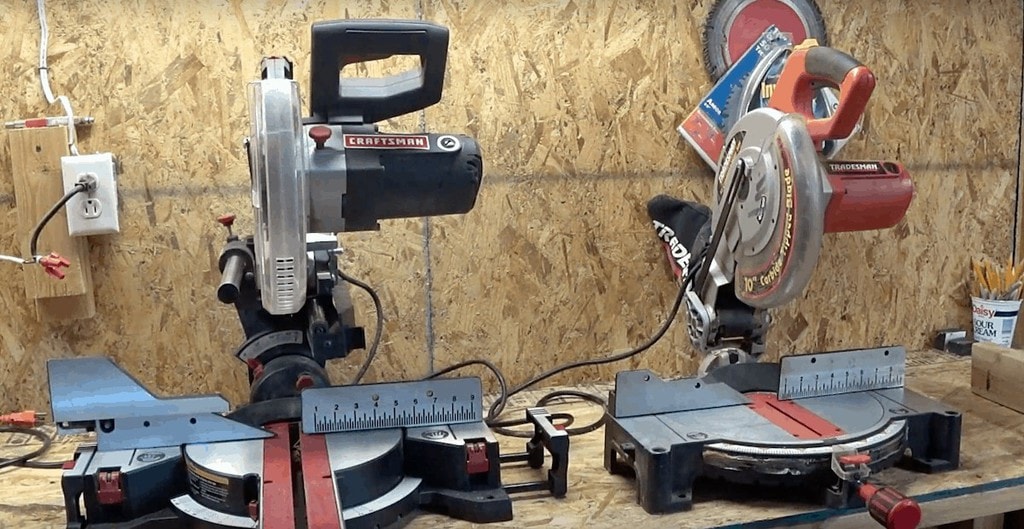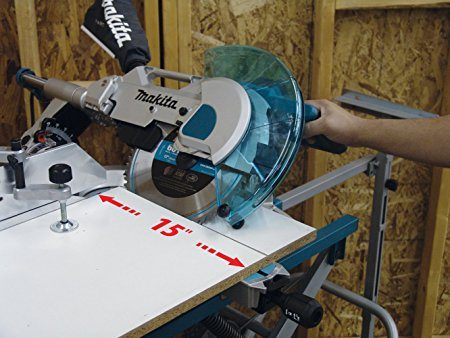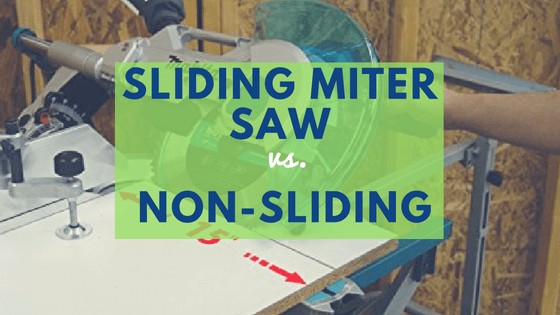
Miter saws are intimidating-looking machines; they’ve got loads of knobs, levers, and complex looking adjustments, and they come advertised with tricky-sounding phrases like ‘dual-bevel’ and ‘compound sliding’.
In a nutshell, miter saws basically come in three different varieties: standard, compound, and sliding.
A standard miter saw is basically a chop saw that has the ability to make angled cuts, or ‘miters’. Compound miter saws can make both miters and bevels, (for the average woodworker it’s rare to have to cut bevels), and lastly, on a sliding miter saw the blade slides out, allowing for the ability to cut wider boards.
Here’s a simple, fantastic video from the Woodworkers Guild of America discussing a few miter saw basics.
In this article, we’ll mostly discuss the advantages of a sliding miter saw over a non-sliding, and hopefully help you figure out which one is more suitable for you and your particular workspace.
General overview: Sliding vs. non-sliding miter saw
Like we said, the principal advantage of a sliding miter saw is that it allows you to cut wider boards. For a example, a 10” non-sliding saw will allow you to cross cut a board up to about 6” wide, while a 12” non-sliding will work for 8” boards (standard 2×8’s).
With a sliding miter saw, these numbers nearly double; a 10” sliding saw will allow you to cut boards up to about 12” wide, which is super important for cabinetry work as standard cabinet ‘uppers’ are 11 ½”. There’s nothing more annoying than trying to cross cut a piece of wood, and ending up an inch or ½” short and having to flip it around to finish it off.
Miter saw options and varieties
We can’t really think of a power tool that comes in more different options, styles, and varieties than the miter saw. If you’re in the market for one, you’ve got a lot of things to consider: 10” vs. 12”. Standard vs. compound. Single vs. dual bevel. Sliding vs. non-sliding.
All of these different options will affect storage room in your garage, and more importantly – price.
Budget is the first thing you’ll probably want to consider if you’re thinking of investing in a miter saw. Nowadays you can get yourself a good quality 10” non-sliding saw for well under 200 bucks – a top-notch 12” sliding saw, on the other hand, will easily cost twice that much if not more.
How do you decide?
The two biggest factors that determine miter saw prices are blade size (10” vs. 12”), and whether or not it’s a slider.
How do you know if you need a sliding miter saw?
Consider all the different factors we just discussed as far as blade size and maximum range of cut. Also, if you primarily use a table saw for ripping/cross cutting wide boards, and you’re handy with your circular saw, you really don’t even need a miter saw.
However, if you do a lot of mitering (framework, molding, etc), or a lot of milling/squaring of raw lumber, miter saws really can be advantageous and make your life a lot simpler – they’re great additions to the garage, no matter how you look at it.
If you plan on using your miter saw on anything bigger than an 8” board, though, you’ve got no choice other than to go with a sliding saw. On the other hand, if you know you’re going to use the saw 99% of the time to cut 45-degree miters in molding or picture frames, you’ll be just fine going with an inexpensive, non-sliding 10” saw.
One more thing to consider is space and portability.
Sliding miter saws are substantially bigger and heavier than non-sliding saws; they can be a pain to move around. If you’ve got enough space and plan on keeping the saw set up in a semi-permanent location, you’re fine.
However, if you’re one of the many who is cramped for space and has to move out into the driveway or backyard for every project, you may want to seriously consider against a sliding saw – like we said, it’s no cake walk to move them.
Our top picks: Sliding vs. non-sliding miter saws
Considering buying? Here’s a list of several of our favorite sliding and non-sliding miter saws, as well as a few of the best-value buys that you’ll find out there.
(For a link to our in-depth article on the overall best miter saws for the money, click here).
Best non-sliding miter saws
Hitachi C10FCE2 10” Single Bevel Compound Miter Saw
Prices are always fluctuating and changing online, but right now this is the best value buy that you’ll find anywhere. A quality compound miter saw from a trusted brand name like Hitachi? Seriously can’t go wrong here.
Ryobi ZRTS1143L 7 ¼” Standard Miter Saw *Best ‘cheap’ buy*
This is the absolute cheapest option that you’ll find out there for a miter saw that’s worth using. It’s got a tiny 7 ¼” blade, but if you only plan on using it for finish work, picture framing, or small PVC/electrical piping, it’ll serve just fine. An ultra-value, simple, no-frills tool. (Ryobi’s 10” compound miter saw is also a good choice at an insane bargain-price).
DeWalt DW715 12” Compound Single Bevel Miter Saw
This is a fantastic quality tool that, for a 12” compound saw, is really not a bad price. We know there’s plenty of people out there who are quick to bash the ‘bumble bee brand’, be we’ve trusted the DeWalt name for decades and have never been disappointed. Any any regard, a great saw if you know you need the 12” instead of the 10” non-sliding. (Here’s DeWalt’s 10” non-sliding miter saw – substantially cheaper than the 12”).
Also, keep in mind that 12” blades are much more expensive to replace than 10”. (Also, there’s a double bevel version of the 12”).
Makita LS1221 12” Compound Miter Saw
Another great quality tool that’s in the same class as the DeWalt DW715 and 716 – maybe even better quality.
Best Sliding miter saws
This is where things get a little pricey.
Our mentality is this: if you’re going to make the investment in a sliding miter saw, don’t be afraid to spend a couple hundred dollars more on a quality tool; you can find sliding miter saws out there that are the same price as brand-name non-sliding saws, but trust us, you’ll be selling yourself short when it comes to quality.
Also, sliding miter saws are complex tools that need to be designed, engineered, and constructed well in order to perform and last for any length of time at all – if you’re looking at the cheapest sliding miter saws, chances are you’re gonna get what you pay for.
DeWalt DWS780 12” Dual Bevel Compound Sliding Miter Saw
Our overall top pick. Yeah, we tend to get some guff for having a DeWalt as our top miter saw pick, but we’ve used and abused this thing for years on end and really put it through the wringer, and it never fails to come out on top. Not to mention, for a 12” sliding compound saw from a trusted name, you won’t find a much better price. (DeWalt has a 10” sliding compound saw – a good option that’s substantially cheaper than the 12”).
Bosch GCM12SD 12” ‘Glide’ Sliding Compound Miter Saw
A top-class tool, but a little more pricey than the DeWalt. If money wasn’t a factor, we’d go with this one, truth be told. Our favorite feature is Bosch’s new ‘Axial-Glide System’ which eliminates the long arms of traditional sliding miter saws; you get all the increased cutting range of a 12” sliding saw, but save a boatload of space with this new design. (There’s also a 10” version).
Makita LS1216L 12” Sliding Compound Miter Saw

A new addition to the list – we tried this thing out, and were absolutely blown away. We possibly may have just become Makita’s biggest new fans.
This saw is rock-solid and the sliding mechanism (which truth be told feels ‘less than industrial’ on the DeWalt 12”) is second-to-none. At nearly the exact same price as the DeWalt, we’d have no hesitation whatsoever in switching our loyalty and going with this saw if we had it all to do over again. *Our new top pick*. (There’s also a 10” version that’s more affordable).
Bottom Line
One thing we didn’t talk much about is the difference between single and double bevel miter saws; in a single bevel, the saw blade only tilts in one direction.
In a dual – or double bevel – it can tilt either left or right. This is advantageous when (if) you need to cut opposing bevels on each end of your piece – instead of having to flip the board around, you simply switch the orientation of the blade.
However, double bevel saws represent a pretty significant increase in price, and really aren’t worth it in our opinion. If you can save some cash by going with a single bevel instead of a double, don’t hesitate to do it.
All in all, the principal advantage of a sliding miter saw over a non-sliding is that you can cut wider boards.
Depending on what you plan on working on the majority of the time, it can be worth your while to invest in a slider – they’re substantially more expensive than standard miter saws, but well worth it if you’re going to get good use out of it.

